Fabian Gans
Earth System Data Cubes: Avenues for advancing Earth system research
Aug 05, 2024Abstract:Recent advancements in Earth system science have been marked by the exponential increase in the availability of diverse, multivariate datasets characterised by moderate to high spatio-temporal resolutions. Earth System Data Cubes (ESDCs) have emerged as one suitable solution for transforming this flood of data into a simple yet robust data structure. ESDCs achieve this by organising data into an analysis-ready format aligned with a spatio-temporal grid, facilitating user-friendly analysis and diminishing the need for extensive technical data processing knowledge. Despite these significant benefits, the completion of the entire ESDC life cycle remains a challenging task. Obstacles are not only of a technical nature but also relate to domain-specific problems in Earth system research. There exist barriers to realising the full potential of data collections in light of novel cloud-based technologies, particularly in curating data tailored for specific application domains. These include transforming data to conform to a spatio-temporal grid with minimum distortions and managing complexities such as spatio-temporal autocorrelation issues. Addressing these challenges is pivotal for the effective application of Artificial Intelligence (AI) approaches. Furthermore, adhering to open science principles for data dissemination, reproducibility, visualisation, and reuse is crucial for fostering sustainable research. Overcoming these challenges offers a substantial opportunity to advance data-driven Earth system research, unlocking the full potential of an integrated, multidimensional view of Earth system processes. This is particularly true when such research is coupled with innovative research paradigms and technological progress.
DeepExtremeCubes: Integrating Earth system spatio-temporal data for impact assessment of climate extremes
Jun 26, 2024


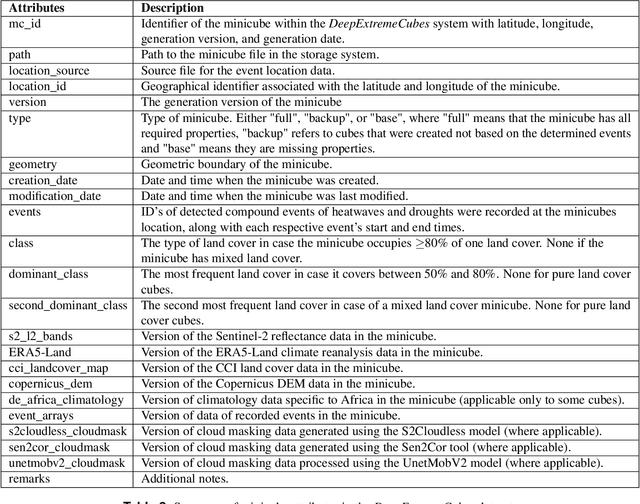
Abstract:With climate extremes' rising frequency and intensity, robust analytical tools are crucial to predict their impacts on terrestrial ecosystems. Machine learning techniques show promise but require well-structured, high-quality, and curated analysis-ready datasets. Earth observation datasets comprehensively monitor ecosystem dynamics and responses to climatic extremes, yet the data complexity can challenge the effectiveness of machine learning models. Despite recent progress in deep learning to ecosystem monitoring, there is a need for datasets specifically designed to analyse compound heatwave and drought extreme impact. Here, we introduce the DeepExtremeCubes database, tailored to map around these extremes, focusing on persistent natural vegetation. It comprises over 40,000 spatially sampled small data cubes (i.e. minicubes) globally, with a spatial coverage of 2.5 by 2.5 km. Each minicube includes (i) Sentinel-2 L2A images, (ii) ERA5-Land variables and generated extreme event cube covering 2016 to 2022, and (iii) ancillary land cover and topography maps. The paper aims to (1) streamline data accessibility, structuring, pre-processing, and enhance scientific reproducibility, and (2) facilitate biosphere dynamics forecasting in response to compound extremes.
The FLUXCOM ensemble of global land-atmosphere energy fluxes
Dec 11, 2018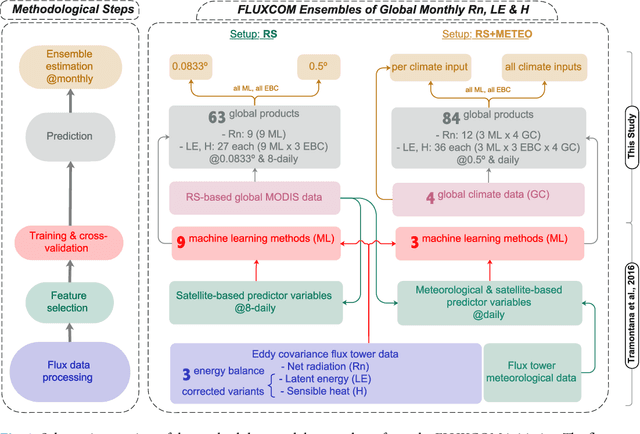
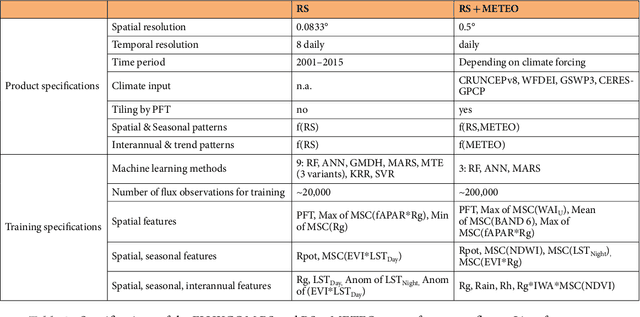
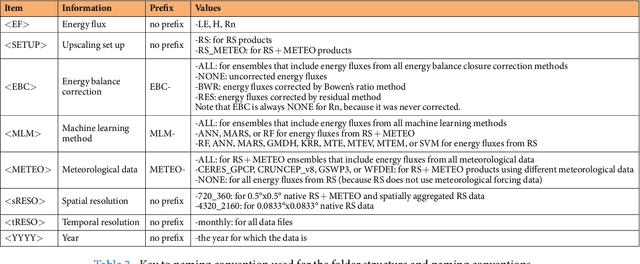
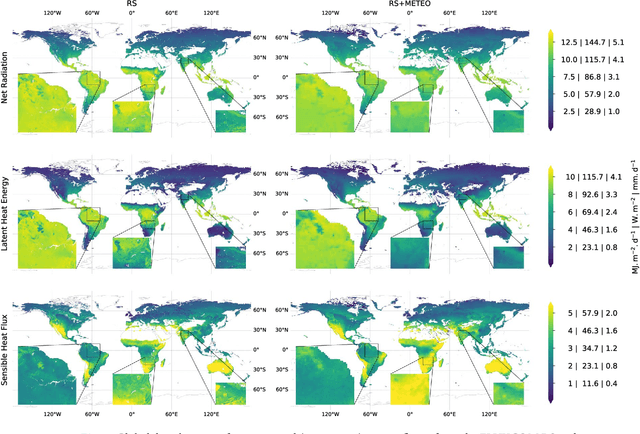
Abstract:Although a key driver of Earth's climate system, global land-atmosphere energy fluxes are poorly constrained. Here we use machine learning to merge energy flux measurements from FLUXNET eddy covariance towers with remote sensing and meteorological data to estimate net radiation, latent and sensible heat and their uncertainties. The resulting FLUXCOM database comprises 147 global gridded products in two setups: (1) 0.0833${\deg}$ resolution using MODIS remote sensing data (RS) and (2) 0.5${\deg}$ resolution using remote sensing and meteorological data (RS+METEO). Within each setup we use a full factorial design across machine learning methods, forcing datasets and energy balance closure corrections. For RS and RS+METEO setups respectively, we estimate 2001-2013 global (${\pm}$ 1 standard deviation) net radiation as 75.8${\pm}$1.4 ${W\ m^{-2}}$ and 77.6${\pm}$2 ${W\ m^{-2}}$, sensible heat as 33${\pm}$4 ${W\ m^{-2}}$ and 36${\pm}$5 ${W\ m^{-2}}$, and evapotranspiration as 75.6${\pm}$10 ${\times}$ 10$^3$ ${km^3\ yr^{-1}}$ and 76${\pm}$6 ${\times}$ 10$^3$ ${km^3\ yr^{-1}}$. FLUXCOM products are suitable to quantify global land-atmosphere interactions and benchmark land surface model simulations.
 Add to Chrome
Add to Chrome Add to Firefox
Add to Firefox Add to Edge
Add to Edge